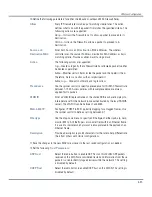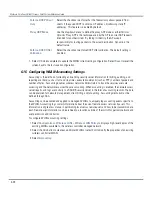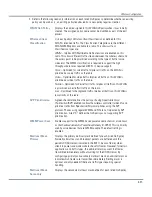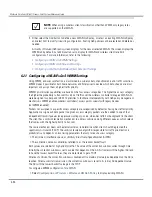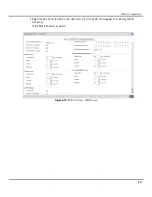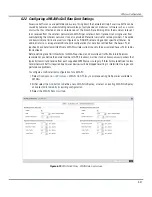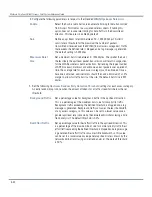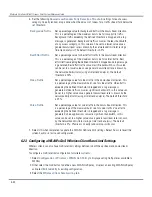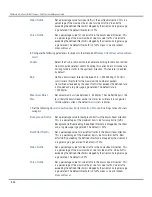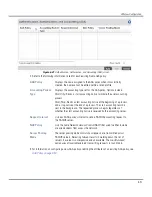
Motorola Solutions AP-6511 Access Point System Reference Guide
6-36
3. Either select the
Add
button to define a new WLAN QoS policy, or select an existing WLAN QoS policy
and select
Edit
to modify its existing configuration. Existing QoS policies can be selected and deleted as
needed.
A
Quality of Service
(QoS) policy screen displays for the new or selected WLAN. The screen displays the
WMM tab by default, but additional tabs also display for WLAN and wireless client rate limit
configurations. For more information, refer to the following:
•
Configuring a WLAN’s QoS WMM Settings
•
Configuring a WLAN’s QoS Rate Limit Settings
•
Configuring a WLAN’s QoS Wireless Client Rate Limit Settings
6.2.1 Configuring a WLAN’s QoS WMM Settings
Using WMM, end-user satisfaction is maintained in a wider variety of environments and traffic conditions.
WMM makes it possible for both home networks and Enterprises to decide which data streams are most
important and assign them a higher traffic priority.
WMM’s prioritization capabilities are based on the four access categories. The higher the access category,
the higher the probability to transmit this kind of traffic over the wireless controller managed WLAN. ACs
were designed to correspond to 802.1d priorities to facilitate interoperability with QoS policy management
mechanisms. WMM enabled wireless controllers/ access points coexist with legacy devices
(not WMM-enabled).
Packets not assigned to a specific access category are categorized by default as having best effort priority.
Applications assign each data packet to a given access category packets are then added to one of four
independent transmit queues (one per access category - voice, video, best effort or background) in the client.
The client has a collision resolution mechanism to address collision among different queues, which selects
the frames with the highest priority to transmit.
The same mechanism deals with external collision, to determine which client should be granted the
opportunity to transmit
(TXOP). The collision resolution algorithm responsible for traffic prioritization is
probabilistic and depends on two timing parameters that vary for each access category.
• The minimum interframe space, or
Arbitrary Inter-Frame Space Number
(AIFSN)
• The contention window, sometimes referred to as the random backoff wait
Both values are smaller for high-priority traffic. The value of the contention window varies through time.
Initially the contention window is set to a value that depends on the AC. As frames with the highest AC tend
to have the lowest backoff values, they are more likely to get a TXOP.
After each collision the contention window is doubled until a maximum value (also dependent on the AC) is
reached. After successful transmission, the contention window is reset to its initial, AC dependant value.
The AC with the lowest backoff value gets the TXOP.
To configure a WMM configuration for a WLAN:
1. Select
Configuration
>
Wireless
>
Wireless LAN QoS Policy
to display existing WLANs.
NOTE:
When using a wireless client classification other than WMM, only legacy rates
are supported on that WLAN.
Содержание AP-6511
Страница 1: ...Motorola Solutions AP 6511 Access Point System Reference Guide ...
Страница 2: ...Motorola Solutions AP 6511 Access Point System Reference Guide 1 2 ...
Страница 24: ...Motorola Solutions AP 6511 Access Point System Reference Guide 2 12 ...
Страница 136: ...Motorola Solutions AP 6511 Access Point System Reference Guide 6 2 Figure 6 1 Configuration Wireless field ...
Страница 318: ...Motorola Solutions AP 6511 Access Point System Reference Guide 10 16 ...
Страница 409: ...Statistics 13 49 Figure 13 31 Access Point Firewall Packet Flow screen ...
Страница 433: ......




